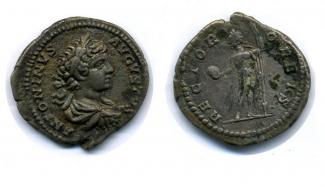Silver denarius of the emperor Septimius Severus
Roman, AD193-211
Found in a garden at Rowlings Road, Weeke, Winchester, Hampshire
With the invasion in AD43 came Roman coins. Most of them were struck at the mint in Rome - it is generally believed that there was no official mint in Britain until the late 3rd century. The mint in Rome at this period struck coins in four metals, gold, silver, orichalcum (roughly modern brass) and copper. The official relationship between the denominations can be summarised as: 1 gold aureus = 25 silver denarii 1 denarius = 4 orichalcum sestertii 1 sestertius = 2 orichalcum dupondii = 4 copper asses 1 as = 2 semisses = 4 copper quadrantes It is difficult to translate the values of these coins into modern money. An approximate idea can be gained from various comparisons, for example, a Roman legionary soldier was paid 225 denarii a year; a litre of wine cost one or two asses, and a loaf of bread could be bought for about two asses.



